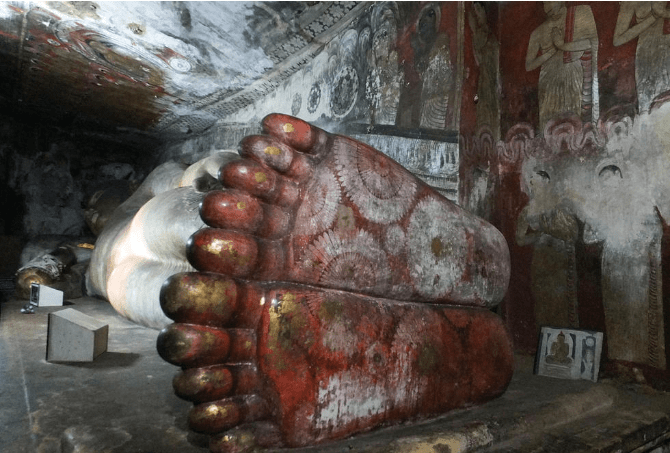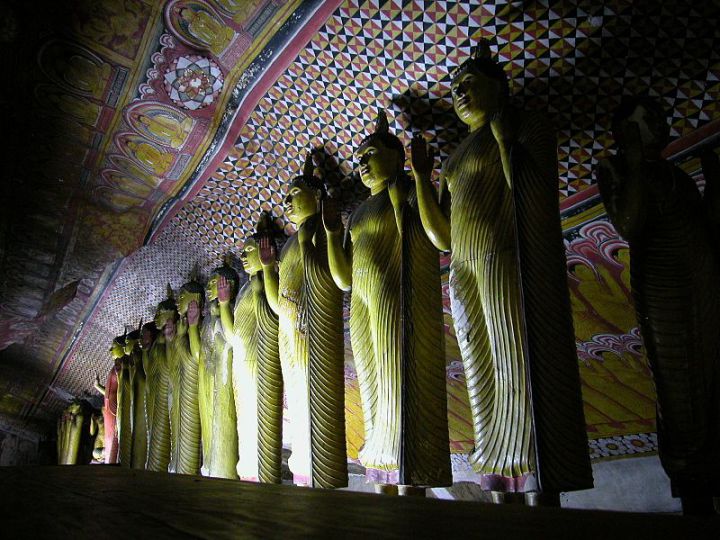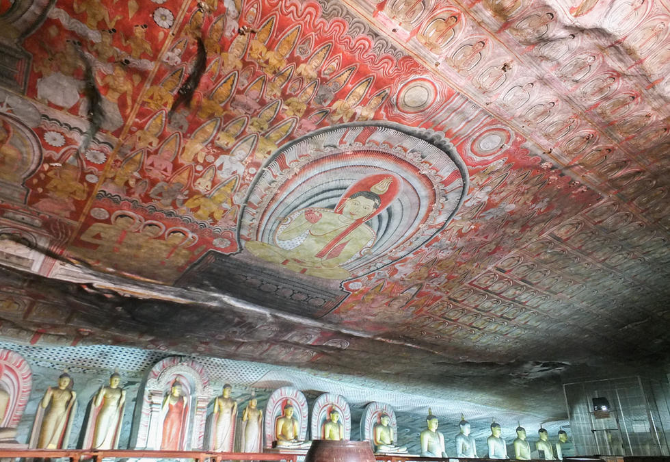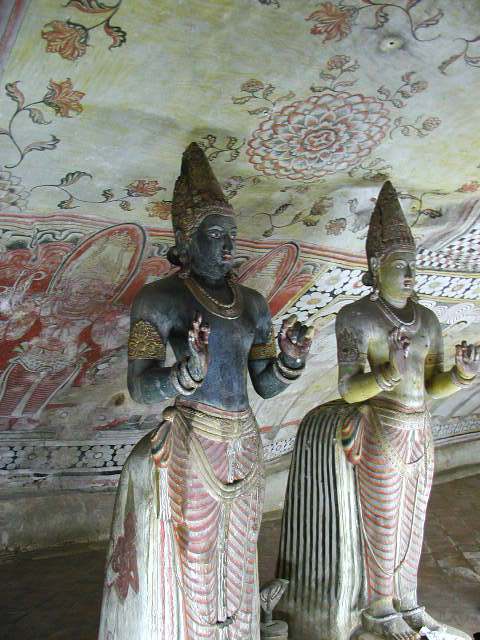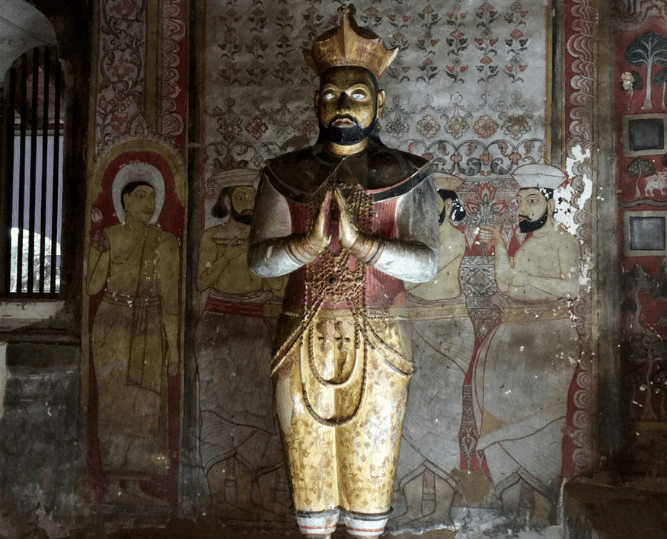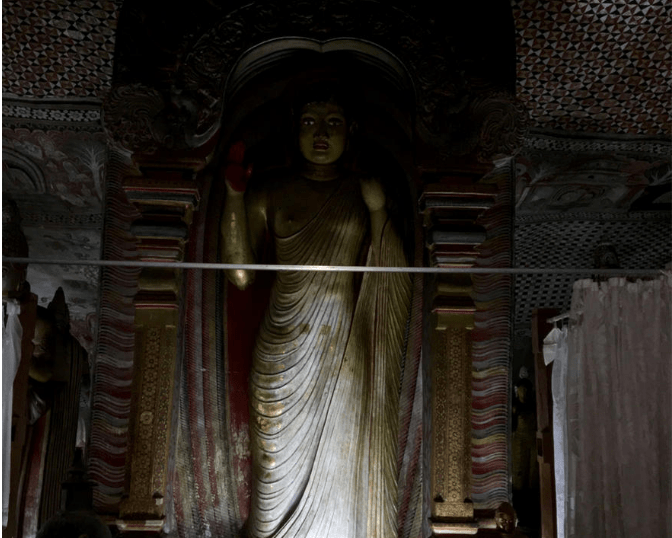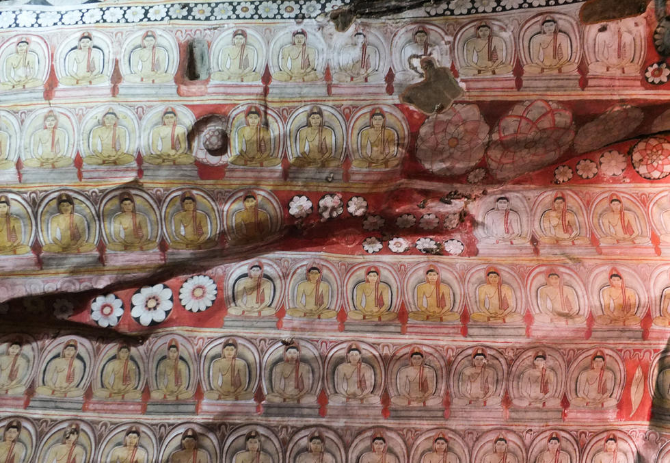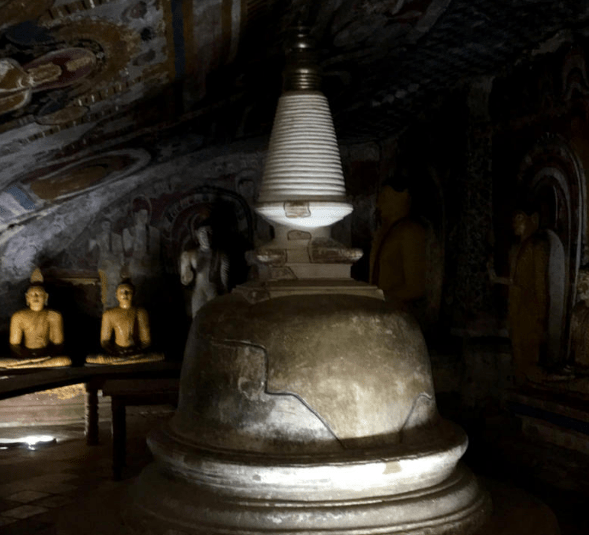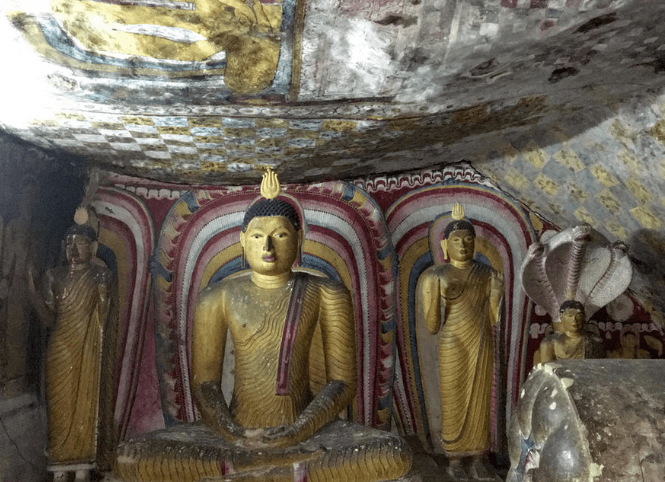
Cave No. 1 :- Devaraja Lena
Cave No. 2 :- The Grate King Maharaja Lena
Cave No. 3 :- Maha Aluth Vihara Lena
Cave No. 4 :- Pachchima Vihara Lena
Cave No. 6 :- Devana Aluth Maha Vihara Lena
CAVE NO.1 :- DEVARAJA LENA
This is supposed to be the oldest temple in the complex. The names of these caves were given in the 18th Century or Kandyan period. There are colossal ‘passing away Buddha’ and three other Buddha images and a statue of his lifelong attendant Most Ven. (Arihath) Ananda. The devotees believe that the passing away Buddha statue is a work of King Walagamba. But historians believe that the statue belonged to the period of 6th to 8th C. AD. It was carved out from the live rock and considered as a master piece of Sri Lankan sculpture. The paintings in this cave are faded and belonged to the Kandyan period. There is a statue of Vishnu one of the three main Hindu gods. The temple of the God Vishnu is attached outside. Worshipping Hindu gods and the introduction of statues of the same was taken place during the Kandyan period and Dambulla is one of the prominent places in that respect.
CAVE NO. 2 :- THE GREAT KING MAHARAJA LENA
Maharaja Lena This is the largest and it is over 52 m. (170 feet) long. There are 60 colourful statues as mentioned above. The statue of king Walagamba is on the left corner. The Buddha statue in front of the second entrance belongs to the 8th to 9th C. AD. All other statues represent the Kandiyan School of art. The face with eyes opened, thick lips, the robe and red shawl, and the nimbus (Siraspota) are the main features of the period. The serenity of Buddha’s face is no more due to the Hindu influence to the Sri Lankan art.
There is water way up above, seemed to have flowed upwards and it is shown with the painting of fish. The temple uses the water for religious rituals.
The ceiling of this cave and all other caves are full of Buddhist murals. The Buddha’s images, the stories of Buddha, and important incidents of the Sri Lankan history are depicted by these murals. One of the significant and the largest panel of the paintings is the “Mara Parajaya ” the defeat of illusions and suppress of craving or the moment of Enlightenment of Ascetic Siddharta. These paintings are done by folk artists coming from traditional families called ‘Sittara’. They paint what they see. E.g. There is a ‘devil, or a representative of evils in the panel is aiming a gun at the Buddha! The technique of painting is ‘tempera’, painting on dry plaster, which is different to Sigiriya. All pigments and the bonding material for the paintings are from nature. Elsewhere one can observe traditional designs with traditional motifs.
CAVE NO.3 :- MAHA ALUTH VIHARA
This shrine was built during the reign of king Keerthi Sri Rajasinha. His statue too can be seen in the cave. Observe the royal paraphernalia. There are about 57 Buddha statues of standing, seated and reclining. The main Buddha statue is in the beautiful dragon (Makara) arch.
The ceiling is full of paintings and there is a panel of beautiful forest and three figures of Buddha on the wall.
Devotees believe that forest depicts the Himalaya and according to the Hindu mythologies, the greatest things and powerful animals in the world like the Tree of life, Mahameru, ‘Anotapta wila’ which is supposed to be the source of the water and a King Cobra called Ananata etc are found in Himalaya. But the three Buddha figures which represent the past, present and future Buddha are greatest above all.
CAVE NO. 4 – PACHCHIMA VIHARA AND
CAVE NO. 5 – DEVENA ALUTH MAHA VIHARA
Are the same with Buddha statues and paintings. For the tourists, there is no difference. When you come out, look up the ceiling of the eve of the third cave where you can see remains of Polonnaruwa period paintings.
ROCK AND WALL PAINTINGS
The paintings which belong to the 18th Century murals form the most important artistic heritage of Dambulla. They cover an area of more than 2000 sqm. spreads over the uneven surface of five caves. These murals are the largest preserved group of rock and wall paintings of the region. The paintings display an enormous variety of style and subject matter. The paintings depict the life of Buddha story of Buddhism in Sri Lanka and thousand Buddhist images ( Dahas budun).No Jataka stories can be seen. These paintings have been created by folk artists. It is proved by the painting which depicts “Mara Parajaya” (The moment of enlightenment of Prince Siddharta.) at the “Maharaja Lena” A family called ‘sittara’ whose generations involved in paintings live close to Dambulla.
THE TECHNIQUE
Unlike Sigiriya, the paintings in Dambulla is the technique called ‘Tempera’, painted on a dry plaster which is thin and made of clay mixed with cow dung. A bonding agent or a thinner has been used. The most pigments are taken from nature and used oil of bark of Dorana tree to varnish and to preserve from insects.


